 From:
Fouad Major [in code: fmmajor at verizon dot net]
From:
Fouad Major [in code: fmmajor at verizon dot net] Sent: Wednesday, September 05, 2007 7:07 PM
Subject: MAJOR.3.pdf
Books
On this page we will feature books that have been authored by or about people in or from Shweir...
Latest Book:
************
Books By: (Links are in Alphabetical order by Author last name)
Grace Halabi
Elias Khnaser
Hala Khoury
Elsa Marston Harik
Khalil Hawi
Jamil Eid Khonaisser
Fouad Major (Mujais)
Bechara Merhej
Chef Ramzi Shwayri
Karim Nasser
Salim Mujais
Ibrahim Mitri Rihbani
Dr. Fouad Major (Mujais)
Quantum Beat
Second Edition
 From:
Fouad Major [in code: fmmajor at verizon dot net]
From:
Fouad Major [in code: fmmajor at verizon dot net]
Sent: Wednesday, September 05, 2007 7:07 PM
Subject: MAJOR.3.pdf
Dear Anwar, I thought you may want to include among books by authors from Shweir the attached cover picture of the second edition of my book on atomic clocks.
Regards,
Fouad
Major (Moujaes)
Severna Park,
Maryland
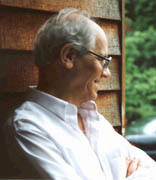 About
the Author, F.G. Major:
About
the Author, F.G. Major:
Now a leading authority on atomic clocks, F.G. Major began his career in 1949 with an undergraduate degree from the University of New Zealand, where, for his M.Sc. thesis he designed and built an experimental digital sequence control unit to operate a Wilson Cloud Chamber.
Following a teaching post at The American University of Beirut, In 1962 he earned a PhD in Physics at the University of Washington, Seattle, working with Prof. Hans Dehmelt on radio frequency spectroscopy of He ions using the Paul ion trap. Having completed his Post-Doctoral work at Yale with Vernon Hugh's group, he joined Gernot Graeff's team at the Physikalisches Institut, University of Bonn, at the invitation of Dr. Prof. Wolfgang Paul, where he did research on magnetic resonance spectroscopy of free electrons.
In 1967 he joined Andy Chi in the Advanced Development Division at NASA/Goddard Space Flight Center, where he did the basic research on mercury ions as the basis for a new spacecraft mercury ion frequency standard. His seminal article on the observation of ultra-narrow resonance in the microwave spectrum of field-confined mercury ions was published in 1972 in the Physical Review Letters. Leaving NASA in 1973, he continued his work on the optical pumping of ions in collaboration with the Audoin group at the Laboratoire de l'Horloge Atomique at Orsay.
As an educator, in 1977 Major accepted a professorship in the Physics Department of the University of Kuwait, where he helped establish a modern physics student laboratory and a laser atomic spectroscopy research laboratory, first applied to the radiative lifetime of atomic states in calcium. He returned to The Catholic University of America as Visiting Professor in 1989, and collaborated with Herbert Ueberall in developing theoretically a polarimetric technique for the study of laser scattering from small particles. In 1994 began work on The Quantum Beat, which was published by Springer-New York in 1998. This second edition was published in June 2007.
************
Dr. Karim Nasser,
Professor Emeritus, Philanthropist and Developer
Launches his 2nd Book on April 3, 2013:
How to achieve your dreams

http://announcements.usask.ca/donor_news/2013/04/inspiring_students_to_follow_t.html
Dr. Karim Nasser, with his
daughter May Nasser, wrote
"How I Achieved My Dream"
This Book is about the dream of a young boy from Shweir, and how he not only achieved his dream, but set in motion a plan to help dozens of other young students in North America and Lebanon achieve theirs.
The book covers interesting and fun stories about town folks, traditions and customs in the mid 1900's in Shweir. The story takes this young boy on a journey studying at schools in Lebanon and in Canada. Then working and teaching at a Canadian University and inventing worthwhile and easy mechanism to test the proper consistency of cement which is named after him.
A few active Shweir.com Family members received a copy. For those of you in Shweir, there is a copy in the Shweir Library and we will bring more copies to each school library in Shweir by early August so that you can get a chance to read it.
Until then, we will tease you with a few pages...
If you wonder what kind of present to give a person who got everything? This book would be the perfect gift.
In the Fall, we hope to set up a virtual store so that you buy a copy...
Royalties will be donated to Shweir Foundation, Shweir Scholarship fund, AUB and other universities.
See also related link at Karim Nasser Web page
************
 |
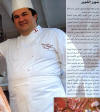 |
 |
 |
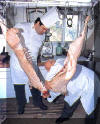 |
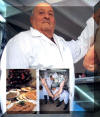 |
 |
Congratulations Ramzi on your Book.
How do people order your book? Where can they sample your food? |
"Traditional Lebanese Food" is the title of
two same books, one in Arabic, "Al-Matbagh al-Lubnany al-Turathy" and in French,
"LE Patrimoine Culinaire du Liban" by Chef Ramzi N Choueiri. The books have
plenty of beautiful lovely scenes from Lebanon with delicious Lebanese food
recipes. I am sending you few (7) images from the book where Shweir is
the title. I hope you will enjoy it the same way I did with the book.
Riad
****************************************
First day comments from the Shweir Bulletin Board (BB)
| Author | Topic: Chef Ramzi | ||
|
|||
|
|||
|
|||
Al Kafa'at is more than a school, its almost a
university. The main buldings are in Masourieh, after Beit Mery and Broumana. I
will send you all the information when I have it. One of the schools is the
cooking, where chef Ramzi is the director. The location of the institution was
before in Haddad where Nadim Shweiry and his wife started a place where they
used to treat and help kids with defferent disabilities. I will tell you more
when I get all the information. Anyway Nadim wrote a book "Kuluna Mou3akoun" "we
are all handicapped".
Riad.
More information will published soon on how and where to buy it...
Books by Dr. Salim Mujais in Illinois, USA
جبران في حبه العاصف الأول
الأحد, 24 يناير 2010
لندن - أحمد أصفهاني
كشف جبراني جديد يحمله كتاب سليم مجاعص «جنية النبي: وثائق ومراسلات حبّ جبران الأول» (دار كتب، بيروت). رسائل بالإنكليزية وجهها جبران خليل جبران الى الأديبة جوزفين بيبودي بين 1899 و1908، وهي المرحلة المبكرة من نشاطه الإبداعي. وجوزفين هذه هي حبه الأول وراعيته الأولى بغض النظر عما كتبه عنها ميخائيل نعيمة وغيره ممن تناولوا تلك العلاقة مركزين على الجانب الجنسي فيها.
الباحث سليم مجاعص عثر على إثنتين وثمانين رسالة من جبران الى جوزفين محفوظة مع أوراق أخرى للكاتبة في إحدى مكتبات جامعة هارفرد. وإلى جانب هذه الرسائل، يوجد نص يتجاوز الخمسين صفحة بعنوان «الروحاني»، هو في الواقع تدوين لما كان يدور بين الإثنين خارج إطار اليوميات المعتادة. والحقيقة ان يوميات جوزفين كانت معروفة منذ سنوات عدة، وقد اعتمد عليها أحد أقرباء جبران ويدعى خليل جبران أيضاً لإنجاز كتاب موسوعي بالتعاون مع زوجته جين صدر بالإنكليزية عام 1998 تحت عنوان «خليل جبران: حياته وعالمه».
إذن نحن أمام إثنتين وثمانين رسالة معظمها لا يتجاوز الأسطر المعدودة، وغالبيتها تركز على مشاعره نحوها. ولقد أدرك مجاعص منذ البداية ان نشر الرسائل كما هي سيبقى عملاً ناقصاً ما لم تتضح الظروف المحيطة ببداية هذه العلاقة وتطورها ثم وصولها الى طريق مسدود انتهى بزواج جوزفين وانقطاع الصلة منذ العام 1908 تقريباً وحتى تاريخ وفاتها العام 1922.
المنهج الذي استخدمه مجاعص يقوم على إعادة تركيب السياق العام للرسائل اعتماداً على مجموعة من المصادر الأخرى المتوافرة. الرسائل هي العمود الفقري، تليها يوميات جوزفين ورسائلها كما وردت في كتاب خليل وجين جبران، ثم مقاطع من «الروحاني» تتوافق مع تواريخ الرسائل، وأخيراً شذرات من مقالات جبران وقصائد جوزفين ما يلقي اضواء كاشفة على المرحلة التي تغطيها الرسائل.
وهكذا يسير القارئ في منحى تصاعدي منذ ان قدّم «الفتى السوري»، كما تصفه جوزفين، إحدى لوحاته الى هذه الأديبة التي زارت أحد المعارض والتقته صدفة هناك عام 1898... مروراً بتبادل الرسائل بينهما بعد عودة جبران من لبنان حيث كان يناديها «الآنسة بيبودي» أو «عزيزتي جوزفين» (عام 1902)، ثم «صديقتي الحلوة» (عام 1903)... وأخيراً «حبيبتي الحلوة».
غير ان الصورة ليست مكتملة تماماً، ذلك ان جوزفين أقدمت على إتلاف عدد من رسائل جبران لأسباب مجهولة. ففي يومياتها لشهر تشرين الأول (أكتوبر) 1903، نقرأ التالي: «10 تشرين الأول 1903 - رسالة من جبران مع اقتراح مغيظ. 12 تشرين الأول 1903 - الكل محبطون مكدرون. 13 تشرين الأول 1903 - مراجعة الرسائل القديمة وتمزيقها».
ويبدو ان المشكلة كانت أعمق مما توحيه هذه العبارات، ففي رسالة من جوزفين الى إحدى صديقاتها بتاريخ 6 أيلول 1903، تستخدم العبارات القاسية التالية: «كان من دواعي أسفي الشديد ان محمي السوري جاء لزيارتي في وقت زيارتكما. وكنت أرسلته الى بيته أو أبقيته خارجاً لو لم يكن حملاً في أزمة. انه من نعاج الله الذي أوتي لي ان أطعمهم من وقت الى آخر»!
غير ان سوء الفهم هذا لم يستمر طويلاً، إذ نجد ان جبران عاد الى مراسلتها في حين واصلت جوزفين تسجيل يومياتها ورصد انطباعاتها في «الروحاني». لكن وتيرة التواصل تراجعت عما كانت عليه في السابق... علماً بأن حرارة المشاعر التي واظب الإثنان على التعبير عنها لم تخفت إطلاقاً.
ومع ان رسائل جبران تحتوي تفاصيل شخصية عن وفاة أخيه ثم أمه، وبعد ذلك توليه تدبير الأعمال التجارية للعائلة... إلا ان مضمون الرسائل يؤسس لعلاقته الخاصة بجوزفين وسعيه الدؤوب الى الفوز بها، أو على الأقل الحصول على صداقتها الحميمة. وهذا بالذات ما يسبغ على هذا الكشف الجبراني الجديد أهمية لا تفوقها إلا الوثائق التي أصدرها توفيق الصايغ في كتاب «أضواء جديدة على جبران»، وهي وثائق ذات أجواء مماثلة من حيث ان جبران كان يتعامل مع إمرأة أجنبية (ماري هاسكل) مدركاً انها رسائل ويوميات خاصة لن تجد سبيلها الى النشر خلال فترة حياته أو حياة متلقيتها. (ولنقارن ذلك، على سبيل المثال، مع رسائله الى مي زيادة المنشورة في كتاب «الشعلة الزرقاء»).
ولقد أحسن الباحث سليم مجاعص والناشر بدر الحاج صنعاً بنشر النصوص الإنكليزية كاملة في القسم الثاني من الكتاب، إذ اننا للمرة الأولى نقف على علاقة جبران باللغة الإنكليزية التي تصفها جوزفين في آذار عام 1899 بأنها «لغة إنكليزية ركيكة مفككة لكن معاني ولا أكمل». أما الرسائل المتأخرة بعد عام 1904 فتظهر نضجاً واضحاً وامتلاكاً لناصية التعبير، وهو أمر كان سيجد كماله مع ماري هاسكل التي راجعت وإياه مسودة كتاب «النبي» قبل نشره.
أما وقد أصبحت هذه الوثائق بين أيدي الباحثين، وسبقتها وثائق توفيق الصايغ، وأيضاً كثير من رسائل جبران الى نساء عربيات وأجنبيات منشورة هنا وهناك في كتب تحاول جمع التراث الجبراني المفرق... فقد بات لزاماً دراسة هذه الرسائل ليس فقط من حيث إضاءتها على حياة جبران ونتاجه الإبداعي، بل أيضاً من النواحي النفسية العميقة بهدف إظهار كوامن جبران الدفينة وكيفية استخدامه تلك العلاقات النسائية من أجل تعزيز نوازع نرجيسية رافقته طيلة حياته. تكتب ماري هاسكل في يومياتها بتاريخ 6 أيلول 1914 ناقلة حواراً مع جبران حول جوزفين: «كانت مثل ذاتها، تلبس الثياب ذاتها. لا شيء جديد، لا تغيير... تصوري، لمدة ثلاث سنوات كنت أذهب لزيارتها مرتين في الأسبوع! كانت تكتب أفضل أعمالها في ذلك الوقت. أقول بصراحة انني أوقن انني أثرت في نتاجها على رغم انني كنت في الثامنة عشرة من عمري فقط».
رسائل جبران الاثنتان والثمانون المنشورة في هذا الكتاب تقدم لنا صورة مختلفة.
See Photos of Book Signing By Riad Khuneiser
| Topic: A New Book by Salim Mujais about Antoun Saadeh | ||
|
||
************************
Article from Annahar
http://www.annaharonline.com/htd/EDU070420.HTM by John Dayeh On Arpril 20th
2007
in Adab, Fiker and Fann section
بعدما قرأ الأب الدكتور يواكيم مبارك تصميم أطروحة الدكتوراه التي قدّمها له أحد الطلاب اللبنانيين في جامعة السوربون والمتمحورة على سيرة خليل سعاده (1857-1934) وإنتاجه، طرح عليه السؤال الآتي: أين الفصل الخاص بأنطون سعاده؟ بالطبع، لم يطرح الأب الدكتور هذا السؤال لمجرد ان أنطون هو ابن خليل سعاده، بل لأن الأول لم يكمل دراسته الثانوية في "برمانا هاي سكول" بسبب ظروف الحرب الكبرى، ولا في أي مدرسة أخرى باستثناء "الجامعة" التي يمكن إطلاق اسم "الدكتور سعاده" عليها. فقد درس الابن على أبيه، منذ التحق به في البرازيل عام 1919 وهو في الخامسة عشرة، قواعد اللغتين العربية والانكليزية، وعلم الصحافة، وبخاصة الكتابة في السياسة الدولية، وعلمَي الاجتماع والسياسة، والخط العربي المائل، والوطنية والمناقبية. |
Other Books by Dr. Salim Mujais:
The descriptions are in Arabic taken from the introductions of the books themselves. This is not a complete list as 4 other books are not listed, but I need to scan the covers before I can send them to you.
To contact Dr. Salim: mujaiss @
baxter.com
(Please note that this email has spaces before and after the
"@" for privacy to minimize Spam, please delete those spaces in order to make it
a valid email address)
ديك الجن الحمصي، تهافت الرواة وشفافية النص
تأليف:
سليم مجاعص
|
************************************
رسالة الغفران
تأليف: أبي
العلاء المعري
تحقيق: سليم مجاعص
|
رسالة الغفران من أثمن روائع الأدب
النثري العربي القديم، تكمن فيمتها في مزايا عديدة
ليس أقل أن كاتبها هو أبو العلاء
المعري. هي في العدد نموذج رائع للتخيل الفني
بالتفاصيل، المجدد في الجماليات،
المتنوع في التصاوير، الحافل بالمعاني، الفكاهية
والفلسفية وهي ثروة لا تحد بغناها
اللغوي، وتوسعها الأدبي، حوت نماذج من شعر ما يزيد
على ثلاثين شاعر وأديب، ومباحث
في اللغة والصرف والنحو، وأتت على بحر من المفردات
ليس له مثيل في أي عمل أدبي سابق
أم لاحق. لكن قيمة رسالة الغفران، تكمن في ما هو
أهم من غناها اللغوي وغزارتها
الأدبية وتجديدها الجمالي. قيمتها أنها تحمل في
ثناياها أصداء موقف فلسفي من الدين
والدنيا وضعه صاحبه في إناء أدبي كثرت ثناياه حتى
كادت تضيع ملامحه.
فرسالة الغفران في معناها الأخير موقف فلسفي من الدين والدنيا ومن الأدب والحياة. موضوعها كرحلة في الماوراء وهي تعكس موقف المعري من الدين والتخيل الديني الذي هو متوافق مع موقفه فهما في تراثه عامة، إذ نجد في لزوبعاته أصداء سخرية رسالة الغفران من بعض التصورات الدينية التي يرينا المعري أن لا مكان لها في شريعة العقل. وفي رسالة الغفران يمارس أبو العلاء التصوير الكاريكاتوري الساخر نفسه الذي مارسه في رسالة الملائكة، التصوير الذي يمثل المستحيل المستحب عند الصغار وعند الكبار الذين يفهمون ما وراء تصوير المستحيل.
بالإضافة إلى ذلك ففي رسالة الغفران موقف من الأدب والأدباء نجده واضحاً في نوعية الأدباء الذين اختارهم أبو العلاء لأوار في مسيرة رسالته، وفي من أقام منهم في الجنة، ومن وضع في النار منهم، كما في تفاصيل المباحث الأدبية واللغوية التي يدور حولها الحوار والمعري يمارس أيضاً نوعاً جديداً من النقد الأدبي في رسالته هذه، فهو إلى جانب أمور الصرف والنحو يقوم بنوع من الدرس المقارن في الموضوع الواحد. فإذا مرت مثلاً فكرة أباريق الخمر في وصفه للجنان أشنعها بذكر كثير من أبيات الشعراء في الموضوع نفسه مقدماً لنا فرصة مقارنة بعضها مع البعض الآخر والرسالة الكاملة تقع في جزأين الجزء الأول هو وصف رحلة إلى الماوراء، والجزء الثاني بحث في أدب بعض الشعراء من مثل أبي نواس والمتنبي وأخبارهم وغيرهم من الأدباء في موضوع الرد على رسالة ابن القارح لسكان الجنة: بما غفر لكم؟ أما القسم الثاني فهو على أهميته الأدبية لا علاقة له بالقسم الأول وأهميته محظورة بأمور اختصاصية في الأدب والسيرة فلم يتم إدراجه في هذه الطبعة.
ولتسهيل تدبر القارئ لرسالة الغفران تم تقسيم النص إلى فصول والفصول إلى مقاطع
لتبيان مسرى القصة بوضوح أكثر. وفي التمهيد تم تقديم ملخص لأحداث الرسالة مع بعض
التعليق عليها للغاية ذاتها. مع إضافة بعض الحواشي في شرح ما صعب فهمه من المفردات
وتخريج للآيات القرآنية. وتثبيت ملاحق في آخر
الكتاب لها علاقة وثيقة بموضوعه
ومنها، خصوصاً ملحق "أبيات الشك والتحدي" وهو
مجموعة من أبيات المعري في موضوع
الدين والدنيا، تساعد القارئ على تدبر التوافق بين
ما يجده في رسالة الغفران وما
ورد في اللزوميات. ومنها ملحق "رسالة الملائكة"
وتم إيراد بعض المقاطع من هذه
الرسالة على سبيل المثال لشبهها الكبير برسالة
الغفران أسلوباً ومعنى.
إن قيمة رسالة الغفران، تكمن في ما هو أهم من
غناها اللغوي وغزارتها الأدبية وتجديدها الجمالي.
قيمتها أنها تحمل في ثناياها
أصداء موقف فلسفي من الدين والدنيا وضعه صاحبه في
إناء أدبي كثرت ثناياه حتى كادت
تضيع ملامحه. فرسالة الغفران في معناها الأخير
موقف فلسفي من الدين والدنيا ومن
الأدب والحياة.
بعل هداد: دراسة في التاريخ الديني السوري القديم
تأليف:
حسني حداد و سليم مجاعص
|
يضم الكتاب بحثاً يتناول من خلاله
الأساطير الأوغاريتية التي تفضي إلى القول بأن
الدين السوري القديم لا يزال حياً،
وأن الكثير من الأفكار والصور الدينية التي تجلت
في هذه الوثائق كان لها أثر كبير
على الفكر الديني الذي لا يزال مسيطراً على
اللاهوت الحديث من جهة، وعلى الدين
الشعبي العام من جهة أخرى... وأن البعل هداد بطل
هذه الأساطير هو بالذات الإله
الكوني المعروف في جميع أنحاء الهلال الخصيب
والحضارات المجاورة وأنه بصفته الإله
الذي لا يموت ويعود إلى الحياة قد ترك أثراً لا
يمحى على المسيحية. يعالج هذا البحث
على ضوء تفاصيل عبادة البعل هداد من نواح ثلاث:
1-انتشارها الجغرافي الواسع في
الشرق الأدنى القديم، 2-خاصيتها وصفاتها الأساسية
الثابتة رغم التنوع العبادي
الشكلي، 3-ديمومتها التاريخية عبر أطوار دينية من
عهد تعدد الآلهة إلى عهد
الوحدانية الصارمة.
أناشيد البعل-قراءة جديدة للأساطير الأوغاريتية
تأليف:
حسني حداد و سليم مجاعص
|
شغلت نصوص أوغاريت المتعلقة بالبعل الدارسين وظهرت ترجمات عديدة لها إلى معظم اللغات الحية وبحوث مستفيضة حولها. وقد نتج التكاثر في الترجمات عن طبيعة العثور عليها، ومصادفات التنقيب فاللوحات المتعلقة بالبعل عديدة وكثير منها أصاب أقساماً منه التلف، والترتيب القديم الأصلي للوحات غير معروف تماماً.
وقد تركز هم الباحثين الأوائل على الاستفادة من النصوص الأورغاريتية لإلقاء أضواء جديدة على التوراة والديانتين اليهودية والمسيحية والمفارقة الكبرى هي أنه رغم كون العبرانية والأوغاريتية تنتميان إلى عائلة واحدة من اللغات. إلا أن العربية هي الأقرب في تصويتاتها إلى الأوغاريتية من العبرانية، وبما أن القاموس العربي هو بالحقيقة متحف واسع للكلمات القديمة والحديثة، لذلك عمد المؤلف إلى إعداد هذه الدراسة التي يدون فيها المؤلف بترجمة عربية أدبية جديدة لهذه النصوص مصنفاً إياها إلى ثلاثة أناشيد هي أولاً: صراع بعل ويم، وثانياً: بناء قصر لبعل، ثالثاً: صراع بعل وموت، وموت بعل وقيامه. والسبب الذي دفع الباحث إلى تقسيم الأناشيد هو ظنه أنها تحمل في طياتها تراثاً شفوياً سابقاً موغلاً في القدم والسبب الآخر هو أن لهذه الأناشيد وظيفة احتفالية طقسية. هذا وقد ألحق الباحث دراسته بمعجم بأسماء وصفات الآلهة وملحقاً بالملاحظات على اللغة الأوغاريتية ومشاكل الترجمة إلى العربية.
أنطون سعاده والاكليروس الماروني
تأليف:
سليم مجاعص
|
يقول المؤلف في مقدمة كتابه إن فكر
أنطوان سعادة يدفع ثمن الممارسات والأغلاط
السياسية للحزب السوري القومي الاجتماعي
بكافة أقسامه، وإعراض الناس، كثيرهم أو قليلهم؛ عن
فكر أنطوان سعادة هو لأن الحزب
أو الأحزاب، أخذت هذا الموقف السياسي أو ذاك. وهذا
يشكل جداراً بين أنطوان سعادة
ومن حوله من الناس.
ويرى المؤلف أن بعض من هذا الجدار هو عدم المعرفة من هنا كان الغرض من هذا الكتاب. أنه مساهمة في سبيل المعرفة عبر تحري العلاقة التي برزت بين أنطوان سعادة والأكليروس الماروني منذ بدايات عمله الإصلاحي في الوطن. وقد رأى المؤلف أن يتبع في أسلوب البحث الإحاطة بحالات عينية مخصصة لأجل إعطاء الشاهد من الواقع ولأجل المعرفة التاريخية. هكذا يعالج تباعاً الصراع العلني تارة والخفي طوراً بين الحركة القومية الإصلاحية والمراجع الدينية التي تستمر بالتدخل في شؤون السياسة القومية. فهذا الكتاب ليس بحثاً نظرياً في الموقف العلماني الذي اتخذه أنطوان سعادة بل هو تحر لممارسات هذا الموقف في التاريخ.
يتناول هذا الكتاب بحث العلاقة بين انطوان سعادة والأكليروس الماروني ويظهر كيف إن أنطوان سعادة يقدم في كتابه، وفي موقف حركته القومية العلمانية عامة، أساساً فكرياً مقنعاً بذاته لدخول الموارنة المتحررين من التأثير الأكليريكي في صفوف الحركة القومية العلمانية. وبدل الموقف السلبي من الوحدة السورية والعلمانية الشاملة الذي تقدمه الأحزاب الطائفية، يظهر أنطوان سعادة الموقف الإيجابي الذي يجب على الموازنة اتخاذه على أساس تاريخهم الثقافي الحقيقي لا التاريخ السياسي الذي تقدمه المراجع الأكليريكية والأحزاب الطائفية. فبدل صورة الموارنة اللاجئين إلى الجبل، المنفصلين عن بقية سورية، الشاخصين إلى فرنسا لحمايتهم، يضع أنطوان سعادة صورة الموارنة الذين هم من صلب الشعب السوري ويحملون تراثاً ثقافياً سورياً هاماً ومنهم ينبثق رواد تحرير سورية من مثل جبران خليل جبران.
أنطون سعاده والشيوعية
تأليف:
سليم مجاعص
|
برزت على واجهة العمل الفكري-السياسي
بالحزب السوري القومي الاجتماعي ظاهرة الاتجاه
(الاشتراكي) والتقارب من الماركسية
في كتابات الكثيرين من قادة ومفكري الحزب، وقد
أثارت هذا الظاهرة في فترة الستينات
صراعاً فكرياً مريراً داخل الحزب ساهم في
الانشقاقات والإبعادات والانسحابات.
ومن الواضح أن هذه الظاهرة وردات الفعل عليها قد أثارت مسألتين الأولى هي علاقة الاتجاه القومي الاجتماعي بالاتجاه الشيوعي، والثانية هي توقيت التحول من هذه العلاقة، والمؤلف يعالج الأول منها عبر كتابات ومواقف "أنطون سعاده" وعلاقتها مع كتابات والده الدكتور "خليل سعاده"، وموقف هذا الأخير من الاشتراكية، هذا في الفصل الأول، أما الفصل الثاني فسوف يعالج موقف أنطون سعاده من الحزب الشيوعي حتى استشهاد أنطون سعاده. أما الفصل الثالث فيتناول رأي سعاده وتقييمية للتجربة السوفياتية في العهد الستاليني. وقد اتبع هذه الفصول ببعض الملاحق ضمنها بعض الكتابات والوثائق المرتبطة بموضوع هذا الكتاب والتي يصعب توفرها للقراء والبحاثة، للبحث في موقف أنطون سعاده فوائد جمّة منها معرفة موقف فكر نير، أحاط بمواضيع وأحداث عصره إحاطة شاملة بموقف عقلاني واقعي محلل، وتساعد هذه المعرفة في تدبر مواضيع وأحداث هذا العصر والإحاطة بها. ثم هناك فائدة دراسة التاريخ السياسي للمنطقة العربية عبر تحري علاقة الحزب السوري القومي الاجتماعي بالحزب الشيوعي.
لماذا البحث في موقف انطون سعاده من الشيوعية؟ إننا نرى أن في هذا البحث فوائد جمة منها معرفة موقف مفكر نيّر من بلادنا أحاط بمواضيع وأحداث عصره إحاطة شاملة بموقف عقلاني واقعي محلل، وتساعدنا هذه المعرفة في تدبر مواضيع وأحداث عصرنا والإحاطة بها. ثم هناك فائدة دراسة التاريخ السياسي لمنطقتنا عبر تحري علاقة الحزب السوري القومي الإجتماعي بالحزب الشيوعي. وأيضاً فائدة درس التحولات التي تطرأ على الحركات العقائدية في مراحل عملها السياسي.
Books by Elsa
Marston Harik
Wife of Ilya Harik from Shweir
For Elsa's Home page: http://www.elsamarston.com/index.htm
For Elsa's Biography: http://www.elsamarston.com/bio.htm
For a list of Elsa's Books: http://www.elsamarston.com/works.htm - Following is a Sample
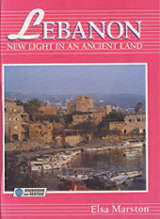 LEBANON:
NEW LIGHT IN AN ANCIENT LAND
LEBANON:
NEW LIGHT IN AN ANCIENT LANDIn Lebanon you can swim in the Mediterranean Sea in the morning and then,
after a lunch of world-famous Lebanese cuisine, go skiing in the
snow-covered mountains. You can see artifacts many thousands of years old,
roam through oriental palaces and medieval castles, and enjoy sophisticated
cafes much like those in Europe. With chapters about the distinctive
Lebanese people, their history, culture, education, economy, and folklore,
the book also summarizes the bitter war that nearly tore apart this small
country--the size of Connecticut--from 1975 to 1991. A balanced,
authoritative introduction to a Middle Eastern land that has had special
ties with the U.S. since the 1820s.
With numerous illustrations. Available in libraries, from online book
services, or from the author.
Two New Children books by a Shweiry Author
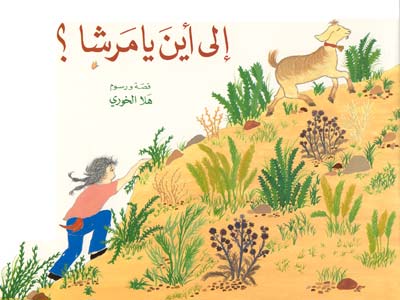
My uncle and aunt, Joseph and Leila Sawaya were the first to
introduce me to shweir.com.
I thought you would be interested to know that Ain El Assis itself has been
featured in an award winning children's storybook.
The story "Ila Ayna Ya Marsha?" (Where to, Marsha?)has won the award of The
Lebanese Board for Books for Young People (LBBY), presented by the Minister of
Education, for both story and illustrations. It has also been nominated on
recommended school reading lists in Lebanon both as part of the curriculum and
for leisure reading.
I wrote "Ila Ayna ya Marsha?" in the Arabic language in an effort to encourage
children to read Arabic books for leisure. The language is simple and easy
flowing and would suit children ages around the ages 7-9. I drew and painted
most of the illustrations while on an extended visit to Dhour Shweir, inspired
by the wondrous nature and the traditional spring of Ain El Assis.
Synopsis: Randa plants flowers in her garden despite the drought in the village.
To solve this problem, she carries water from the village spring daily,
accompanied by her goat Marsha that only drinks from the source of the spring,
as all goats are known to do. When the spring dries out, Randa is determined to
find out the cause and bring water back to her loved spring.
The book is available for those who would like to encourage their children to
read original works about their country at:
www.amazon.co.uk/shops/funzonebooks
Attached are two picture snapshots of the book, for each I have made two sizes,
but they all are relatively small files.
I look forward to your response, and best of luck on your website.
Sincerely
Hala Khoury
Kabkoub al Souf (Ball of Wool Yarn)
By Hala Khoury
Thank you for your interest and encouragement. I have included some information
about my first picture book for children, also inspired by memories of Shweir.
The story "Kabkoub Al Souf" (A Ball of Yarn), features two young children, their
Grandmother and their cat in a traditional Lebanese village home.
The illustrations were inspired by fond memories of the winters I spent at my
grandparents' home in Shweir, near the traditional oven, the 'wjaa'.
Written in simple Arabic language, the story would appeal to children aged 3-5
or over. It has also been nominated on recommended school reading lists in
Lebanon both as part of the curriculum and for leisure reading, and has been
popular with beginning readers.
The book is available for sale at "Amazon" with delivery worldwide using the
following URL link:
http://www.amazon.co.uk/shops/funzonebooks
Synopsis: The story takes place in a traditional Lebanese village home where two
young children watch their grandmother hang some yarn to dry. Grandmother
plans to knit sweaters for the children when the yarn dries. Too impatient to
learn how to roll the yarn, the children decide to take matters into their own
hands... with disastrous, but humorous results.
Best regards
Hala Khoury
Books by Grace Halabi
Grace Halabi Announces her New Website
www.etchmeinstone.com also
see her original web:
www.gracehalabi.com twice won Golden Web Awards
And, check out Grace's new Book A Renascence of Heart and Soul > >
Nice Grace... to use Raouche picture on your book cover. :)
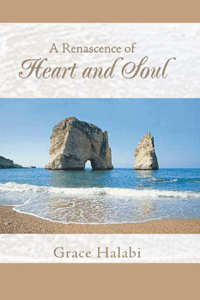
Read about it and Buy
it - Click here
Journey with me into a world where hearts are uncovered, elegantly, gracefully.
Feel my passion as I weave images into verse…. Come closer and listen…
 About
the Author
About
the Author
Grace Halabi began her professional career in 1984 and has a multifaceted
background in public relations, management, sales, marketing and business
development. Multilingual and an accomplished writer, Grace has been selected
for inclusion in "International Who's Who". Grace completed her education in
English Literature at E.C.S.C, Connecticut and lived in South Florida since
1981. Grace was an Executive Vice President for Citibank in Florida before
moving to Michigan in October 1999. She was recruited by Citizens Bank in Flint
to direct and develop their Private Banking Center. A recipient of innumerable
awards for leadership, professionalism, communication and dedication, her
integrity and inspiration have afforded her the respect of all who know her. As
a young female professional, Grace has moved up the ladder of Corporate America
in a very expeditious manner and only due to her diligence and faith in her
talent and skills. A passionate and principled individual, she believes that
passion is the driving force that propels her success train, and that an
individual can leverage change far more effectively than most institutions.
She has a website that she designed featuring some of her poetry-
www.gracehalabi.com
Availability: Usually ships in 2-3 business days.
ISBN 0-8059-9281-2![]() $9.00
$9.00![]()
![]()
Renascence
[E-book edition]
![]() This
book is also available for download as an E-Book in Adobe Acrobat (.pdf) format.
Get the same great book to read on your computer or PDA! It's less expensive and
it saves paper!
This
book is also available for download as an E-Book in Adobe Acrobat (.pdf) format.
Get the same great book to read on your computer or PDA! It's less expensive and
it saves paper!
NOTE: In order to view this e-book, you're going to need the Adobe Acrobat
Reader. Many computers come with it pre-installed, but if you don't have it, you
can get it for free
HERE
![]()
ISBN 0-8059-9281-2 [E-book]![]() $4.00
$4.00![]()
![]() or go to link http://store.yahoo.com/rosedogbooks-store/renbygrachal.html
or go to link http://store.yahoo.com/rosedogbooks-store/renbygrachal.html
FOR IMMEDIATE RELEASE For Further Information contact:
GRACE HALABI
Phone: 248-802-3737
email: Gracehalabi@aol.com
LOCAL AUTHOR RELEASES NEW BOOK A local banker's passion for writing since childhood, is manifested in her anthology of eloquent poetry and rhetoric prose. “It takes courage to articulate all shades of emotion. Let us be heroes of poignant courage ", she says. Grace Halabi has a multifaceted background in public relations, management, sales, marketing and business development. Multilingual and an accomplished writer, Grace has been selected for inclusion in "International Who's Who". Grace was an Executive Vice President for Citibank in Florida before moving to Michigan in October 1999. A recipient of innumerable awards for leadership, professionalism, communication and dedication, Grace believes that passion is the driving force that propels her success train, and that an individual can leverage change far more effectively than most institutions. “Renascence”, profoundly moving with its emotional immediacy, highlights the vitality of her intelligence and the yearning of her imagination. Please visit a website she designed for a glimpse of her eloquent art & poetry at www.gracehalabi.com. To order Grace's book "Renascence”, please go to: http://rosedogbookstore.com/renbygrachal.html Or call: 1-800-834-1803 |
MCSE Designing Security for a Windows Server 2003 Network: Exam 70-298 Study Guide and Dvd Training System Get this book from Amazon Get this book from Barnes & Noble Book Description According to MCP Magazine, there were over 200,000 current Windows 2000 Server MCSEs at the beginning of 2003, and an additional 1.2 million MCP looking to become MCSEs. Syngress has launched a complete line of MCSE 2003 Study Guide/DVD Training Systems (Core 4 plus 3 most popular electives) to publish simultaneously with the launch of the exams. While many industry analysts view the certification market as flat, the reality is that there has been a dramatic reduction in the number of certification series being published since MCSE 2000 and the handful of quality series left should all garner significant gains in market share. The Syngress series was formally published by McGraw-Hill, and the core titles averaged over 40,000 units in retail sales while the electives averaged over 15,000 units each. Through aggressive promotion to our over 70,000 registered users of MCSE 2000 books, strong representation in the retail channel, and the inclusion of a DVD, this comprehensive and unique package is well positioned to attract a major share of the MCSE 2003 certification market. |
||
Configuring Citrix Metaframe XP for Windows, Including Feature Release 1 Get this book from Amazon Get this book from Barnes & Noble Book Description Citrix MetaFrame XP is designed for scalable server farms. It is capable of load balancing user sessions across multiple servers while providing redundancy, security, and ease-of-administration. This revision of the best-selling first edition is the one Citrix MetaFrame XP book you need to plan, design, test, install, configure, and manage your Citrix server. |
||
Citrix MetaFrame XP CCA Certification Package Get this CBT from CBT Nuggets CBT Description Improved application and network performance, rapid application deployment, remote access capabilities and reduced end-user management and support are just a few of the reasons that businesses of all sizes have implemented Citrix MetaFrame XP. Citrix runs on top of Microsoft Windows Terminal Services and provides a unique array of features, functions and management tools to enhance performance and reduce the costs of many computer networks. The Citrix Certified Administrator (CCA) is the entry level certification from Citrix and provides you with the knowledge to run the day-to-day operations of a MetaFrame XP installation. |
|
|
MetaFrame XP for Windows Admin Get this study guide from Cramsession Study Guide Description Citrix’s exam 221, “Citrix MetaFrame XP FR2 for Windows Administration” is one of three exams that qualify for the Citrix CCA (Citrix Certified Administrator) certification. |
| Elias' Bio | |
 |
Elias is the Server Based Computing Architect for General Growth Properties in Chicago. The second largest shopping mall owner and operator in the world. A contributing author for Windows & .NET Magazine, Techrepublic.com, Certcities.com and BrainBuzz.com. Elias currently concentrates on Microsoft and Citrix technologies. |
Congratulations Elias on your achievements
and many thanks for helping your shweir.com family with your valuable IT know
how.
Thanks to Grace Halabi for alerting us to this link Click here: New book explores philosophies of Lebanese poet which led to the article below.
New book explores philosophies of Lebanese poet
Khalil Hawi, modernist, yearned for a contemporary Arab renaissance
Rita Awad
Special to The Daily Star
The problems facing contemporary Arabs and a longing to achieve a new Arab
renaissance were the themes of Khalil Hawi’s poems.
Khalil Hawi: Falsafatu Shiri wal Hadhara (Khalil Hawi: Philosophy of Poetry and
Civilization), an analysis of Hawi’s prose, was recently published by Dar An-Nahar.
The Lebanese-born Hawi’s brilliant literary career spanned three decades, during
which he laid the foundations for a strong Arab poetic tradition through his
five major works: Nahr ar-Ramad (River of Ash, 1957), Al-Nai wal Reeh (The Flute
and The Wind, 1961), Bayadir al-Joo (Fields of Hunger, 1965), Ar-Raad al-Jareeh
(Wounded Thunder) and Jaheem al-Komedia (The Inferno of Comedy, 1979).
Hawi longed to take part in defining the features of a contemporary Arab
renaissance, and was seen as a leading modern poet. He felt the crisis in Arab
culture deeply; for him, this crisis became a personal crusade. The yearning for
an Arab renaissance after as he saw it centuries of decline and decay became
the essence of his epic poetic experience.
Unlike other epic poetry, however, Hawi’s was not merely a simplified adaptation
of established legends, but a completely new rebirth that brought together
ideas, visions and a critical understanding of the past.
His obsession with the future was as effective on the artistic level as it was
destructive to him personally.
Hawi, who was born in the village of Shweir in 1919, witnessed the division of
the Arab world by Europe following World War I. He grew up under Western
colonial rule. In his youth, he wrote, he saw how the stagnant Arab political
system resulted in defeat.
Hawi lived through the period of decline in Arab politics in the 1960s and the
Lebanese civil war. His tragedy culminated in the 1982 Israeli invasion of
Lebanon on the 15th anniversary of the 1967 war.
It was on the night of June 5 that Khalil Hawi decided to leave Beirut forever.
The exile he chose for himself was eternity: a bullet between the eyes. It was
as if Beirut and life were one and the same for him.
Hawi, who was known as one of Lebanon’s foremost modern poets, was also a critic
and a thinker. Yet this aspect of his personality was concealed to most people,
except those who were lucky to have been his students.
Hawi believed that a poet also had to be a critic, something he repeated in his
lectures, press interviews and private meetings. He believed that a good poet
was someone able to pick out vital elements of contemporary and past cultures
and incorporate them in his work. He was driven to assert this position in
response to the complete rejection of tradition by a number of modernist poets.
He claimed that the main characteristic of true modernist poets is that they
“take the revolution forward to expose the truth about our national instincts
and the living elements in our heritage. In attempts such as this, violence is
an essential component without which stagnant values cannot be torn down.”
Hawi believed poetry must penetrate deep into the roots of the social and
political components of national causes. It must be based on old traditions,
turning them into symbols of its own experience.
The deep philosophical culture that characterized Hawi had a profound effect on
his work. He grasped the essence of the human spirit and expressed it
symbolically, using a metaphorical language that was further enhanced by rhythm.
His poetry combined the personal with the political, and the essence with the
aesthetic.
Poetry to Hawi was not a vehicle for ready-made ideas. The purpose he defined
for his poetry was to expose the hidden truths about existence and to express
the absolute.
That was why Hawi defined poetry as “a vision that illuminates an experience,
and an art form that is able to personify that experience.”
Through his experience and talent, Hawi proved the importance of the role the
poet plays in society: the conscience of the nation and the symbol of its
intellect. Modernist poets, he fervently believed, have to personify the
suffering of the nation.
Khalil Hawi: Falsafatu Shiri wal Hadhara (Khalil Hawi: Philosophy of Poetry and of Civilization) was published by Dar An-Nahar. Rita Awad, a Hawi scholar, edited and translated the book and wrote its introduction.
Author: Ibrahim Mitri
Rihbany: 1869-1944
Born In Shweir - Died in USA
|
|
|
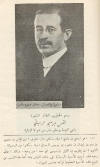 This page about Ibrahim is from an old book |
|
|
Biographical
Summary gathered from
“The Far Journey” and from other books by Rihbany
When Abraham Mitrie Rihbany bid farewell to his hometown of Shwayr and
his adopted town of Btater both in Mt. Lebanon, to immigrate to America in 1891,
he was leaving his native land Syria. When he died in 1944 that part of his
homeland was the independent republic of Lebanon. In between, this great man of
literature, spirituality and politics left his mark on generations of Americans
and Syrian-Lebanese Americans. He still guides believers all over the world
until this very day through one of his books “The Syrian Christ.”
Rihbany was born in 1869 to a poor but proud family headed by a
well-respected stone mason. In 1875, the family moved to the town of Btater in
the Alay part of Mt. Lebanon, where the father was appointed as foreman in
charge of the industrial concerns of a French man, Monsieur Lafortune, who was
known by his Arabised name: Al-Fartouni!
At age 9, and after a brief stint at school, Rihbany started working for
his father as a stone mason. He worked until the age of 17, when he felt a deep
desire to go back to school. He was encouraged by of a friend of his who was
attending the Presbyterian school in Souk Al-Gharb, Mt. Lebanon.
Rihbany restarted school from grade one. He describes in vivid detail the
experience of “this giant” sitting with first grade students. However, he
advanced very quickly, and in two years, he was at a school level commensurate
with his age.
At age 19, his father informed him that he could not spend any more money
on his schooling. Things were bad, and the father had many mouths to feed. So
Rihbnay arranged to teach at the Souk Al-Gharb school in exchange for his
continuing education. As a teacher he worked for three years, two of them at
Souk Al-Gharb, the third at Zahlah, in the Bekaa valley.
It was during that third year, 1891, that two of his friends who were
immigrating to the USA compelled him to join them. He agreed instantly, given
the overall situation of Syria under the Ottomans, and his personal lot of
poverty and heartache at seeing the foreigners better treated than the natives
in his own country. In a matter of days, he was able to obtain an exit visa, and
3 “Napoleon” gold pieces, which his father borrowed for him, and he
journeyed from Beirut to Joppa, Alexandria, Marseilles, and then to New York.
In New York, Rihbany headed immediately to the Syrian colony on
Washington Street. There he worked for a while as an assistant storekeeper until
he met with some educated Syrians with whom he founded the Syrian Scientific and
Literary Society. Later on, one of his colleagues in the society started the
first Arabic newspaper in the New World, Kawkab America and asked Rihbany to be
editor. He worked in this capacity for one year at the end of which the paper
folded due to personal disagreements. But Rihbany did not go back into the world
of commerce like most of his compatriots. Instead, he chose a very peculiar
route, that of talking about the “Holy Land” in American churches for
whatever contribution he could obtain. Thus, with broken English, and with raw
ideas translated directly from Arabic, he embarked on a lengthy tour that took
him to many cities in the mid-west before he was officially invited, after a few
years, to become the permanent preacher in a town there.
In 1913, Rihbany wrote his first book, A Far Journey, in which he chronicled his life until that point, and which he adorned with pictures taken from Syria during a trip accompanied by his American wife. Shortly thereafter, he started to write a monthly article in the prestigious Atlantic Monthly under the heading The Syrian Christ. Those articles were later collected in a book bearing the same title. The Syrian Christ was reprinted 11 times between 1916 and 1922.
Read My Father's House in Atlantic Monthly...
In 1917, he published Militant America and Jesus Christ, a book
advocating the joining of the USA in WWI against the axis powers. And in 1918 he
followed it with America Save the Near East. In this book, he presented a
very tight argument as to why America should take an active role in solving the
“Syrian Question” by advancing east in its campaign, liberating Syria, and
holding it under its protection, as a benevolent power. Obviously, in writing
his book, he was countering the Anglo-French designs on Syria that were calling
for dividing that country into spheres of influence under two mandates, one
British, the other French. His vision for solving the Syrian Question could be
outlined as such: Syrian independence under the protection of the USA; A federal
national government in Syria seated in Damascus with state legislatures in each
of Mt. Lebanon, Aleppo, and Palestine. He also rejected the creation of a Jewish
state in Palestine in a lengthy chapter of the book where he debunked all the
Zionist arguments presented in favor of such an endeavor at that time.
In 1919, Rihbany was elected by the American Syrian Associations (We
don’t know at this time which ones) to be their representative at the peace
conference in Versailles. There, he met with Prince Faisal, and spent three
months with him. That experience, and the political jockeying that he witnessed
in those turbulent times were documented in a book titled Great Men from the
East and the West. Other books that he also penned include The Hidden
Treasure of Rasmoula, Jesus Christ for Boys and Girls, and Seven
Days with God.
Rihbany died in 1944, most likely in Boston.
The Syrian Christ
This book is Rihbani’s masterpiece. He will always be remembered by it. In it,
Rihbany was not trying to add a new theory about Christ’s divinity, but rather
“taking the reader into the inner chambers of Syrian life” without which, he
felt that one cannot understand the true meaning of the scriptures. He goes
through Syrian beliefs, modes of speech and way of life. He rejects the notion
of “The Chosen People” as a narrow and racist view. Rihbany dedicates the
book as an act of homage and love to “My Master, the Syrian Christ.”
**************************
After
a Century of its initial publication in English
The
Syrian Christ
Is Now Available in Arabic
And as of 2004, a new English edition was printed.
First Published in 1916
Reprinted in the
USA 17 times between 1916 and 1937
Published in the UK, at least three editions
Translated into German, five editions
"I could not put The Syrian Christ down until I finished reading the last word in it. It is a magnificent book which should be of special interest to those seeking a better understanding of the psychological, social and cultural background to the teachings of Christ."
Dr. Aida Warah, University of Ottawa
Dear friends,
I am very pleased to announce, on behalf of ApameA, the republication of “The Syrian Christ.” As you may already know, I had the pleasure of translating this magnificent book into Arabic in 2001, and it is now in its second edition. However, many of you have encouraged me to publish the original English text, thus making it available once again to the market for which Rihbany had originally intended it. This I have now done.
I need your help in spreading the message contained in “The Syrian Christ.” I am asking a select number of people to undertake to buy one copy and give at least one copy as a gift to a friend. I will be more than happy to mail, on your behalf, the number of copies that you desire to the intended recipients.
To facilitate the process and avoid one person getting more than one copy through different people, I propose the following process:
¨ Send me the name and address of the intended recipient(s)
¨ I’ll send you back the total amount owing, including shipping by airmail.
¨ Once I get your OK, I’ll immediately ship the book(s), with your compliments.
¨ I’ll create a file for every gift including name of sender, recipient, and date.
¨ Should you send me the name of someone who has already received the book, I’ll notify you immediately, and ask you to think of another recipient.
The book is priced at US$20.00 (CDN$22.95 in Canada). For 5-10 books, a 25% discount will be applied. On orders over 10 books, a 40% discount will be applied. Shipping and handling will always be at cost.
I thank you in advance for your encouragement and support.
For ApameA
Oussama El-Mohtar
Translated into Arabic and published in Beirut in 2001, now in its second edition
Author:
Ibrahim Mitri Rihbani: 1869-1944
Translation and Realization: Oussama El-Mohtar
Publisher: Dar Amwaj
Price: In Canada CDN$20.00 Worldwide US$20.00
Price includes shipping and handling
To order your copy please contact
Oussama El-Mohtar,
51 Parker Road
Pontiac, Quebec J0X 2G0, Canada
Tel: 819-775-8405 or 819-455-9595
Or by email: mohtaro@comnet.ca
25% discount applies on orders of 5 copies or more.
Excerpt from an email:
Given our collective debt to Rihbany and Shweir, I will not limit my contribution to the Christmas season. What I would like to do is offer, perpetually, $5.00 on every book sold through the Shweir.com. I will leave it up to you to decide on allocating this money, although, I would like to see it go to the senior citizens of Shweir. I will leave it up to you to decide on how to announce this small contribution.
Once again, let me thank you. Pretty soon, I hope to be in a position to share with you some more exciting news about Rihbany, and what is being done to revive his memory.
All the best.
Oussama Mohtar
______________________________
Thank you Oussama for your great work on this book and for your offer to help good causes for Shweir.
-----Original Message-----
From: Oussama El-Mohtar [mailto:mohtaro@comnet.ca]
Sent: Monday, December 17, 2001 6:20 AM
To: "Matar, George"; "A. G. Kenicer"
Subject: First sale
My dear good friends:
What a pleasant surprise! The first sale indirectly through Shweir.com came yesterday, courtesy of Mike Sawaya who sent the URL of the book section to a friend of his, Rabih Kassab, in St. Foy, Quebec. The follwoing is a part of the reply I wrote to Rabih before I could access the URL: "Thank you very much, everything seems to be in order. I will mail you the book, in Arabic of course today, and will wait for your cheque. This way you will get the book sooner. But on a different note, please tell your friend from Shweir that the Shweir Scouts have just made themselves $5.00 because I committed to them that any book that is sold through or because of Shweir.com, I will donate $5.00 to the scouts of Shweir."
After sending the email I checked the URL and what a great job worthy of the late Mr. Rihbany. I thank you very much. In a previous email I mentioned some good news that I will be sharing with you. A copy of the book has been sent (Just last week) to the following as a gift: President Lahoud of Lebanon, and their eminences the Patriarchs of the major Churches in Lebanon and Syria, as well as all the major newspapers. Several articles have been written about the book and Rihbany. Those that have come to my attention are: Reuters, An-Nahar, Ad-Diyar, Ath-Thawrah, Al-Mashriq Al-3arabi, as well as a few web sites.
In my letter to President Lahoud I said: "I wanted to bring to Rihbnay's folk knowledge about this superb personality, which, until today remains unknown in its homeland. I hope that the Presidency will take it upon itself to revive the memory of Rihbany and give him the acknowledgement that he deserves." I shall continue to update you as things develop.
Ms. Halabi did meet with Samar Haddad in Beirut last week and the books have been delivered. Ms. Halabi promised to assist in researching the direct family links in Shweir and Btater. Once again I thank you, and I hope more sales will come soon, because I want to instruct Samar Haddad to give the money to the scouts before Christmas.
Once again, thank you and Merry Christmas to you to all the Shweirieh.
Oussama
| Author | Topic: Rihbany and "The Five Interpretations of Jesus" |
| mohtaro Member |
Ya Ahla-Ash-shweir al Kiram: The more I dig into the life and works of Dr. Abraham Mitrie Rihbany, the more I am in awe in front of this great man of spirituality. I am happy to report that Dr. Steven Blackburn has just appraised me of yet another book by Rihbany titled: The Five Interpretations of Jesus. This book was written in 1940, and it includes the following chapters: Jesus of Nazareth, the Prophet; (2) Jesus of Bethlehem, the Messiah; (3) Jesus of Antioch, The Word ; (4) Jesus of Nicea, the Deity; (5) Jesus of the Modern Mind, the Brother and Guide. A great big thank you to Dr. Blackburn. Mukhtar, could Rihbany's bio be updated from this information or do I need to send the updated file that I have? Thanks. Oussama IP: Logged |
| George
Matar Administrator |
Great update, I think Anwar can cut and paste as needed, if he can't I am sure he is reading this thread and will respond to it. Shukran Ya Oussama. You ar coming for a visit to Shweir this summer right? IP: Logged |
| mohtaro Member |
Thank you George, I am sure Anwar can manage with all his technical skills. As for Shweir this summer, it might be much sooner. I am going to be in Lebanon in the third week of March. And I definitely will go to Shweir. I hope Miss Adel Halabi is reading this thread because I really would like to meet her. Now, the reason for my trip is that I have an invitation from the Canadian embassy in Damascus to participate in "Les jour de la Francophonie" with a lecture in French About Ibrahim Mitrie Rihbany and his book the Syrian Christ. The date of the lecture is the 15th of March. After that I will probably have one or two more speaking engagements in Damascus, and then on to Lebanon, where my publisher is preparing similar engagements, and I sure hope that Shweir will be among them. I would like to tell the Shweir community that Rihbany is a giant of a thinker, and reviving his work and legacy should really be a priority. Finally, in the Syrian Christ, Rihbany says that during a wedding, people would praise the bride's courageous father by singing what I translated as: " Bayyek ya hilwi Safar wahdu 3ash-sham", since it was such a long and ardous trip to go on foot, alone, from Mt. Lebanon to Damascus. I will be going to Damascus soon, but I won't be alone. I will have the honour of accompanying Ibrahim Mitrie Rihbany back to Damascus and Lebanon, after a century's absence. All the best. I can't wait to see Dhour again. Oussama IP: Logged |
| B. Hatem Member |
Ossama, I have been wondering for a while now about the Title: "The Syrian Christ". What is that all about? Is it fiction? Perhaps you could shed some light on that title, and what it implies. I had no idea that Christ was Syrian, unless there was another one that no one knew about!! Regards, BH IP: Logged |
| George
Matar Administrator |
Barney, the Syrian Christ is a book we have a lot of information on it in this web page try this link http://www.shweir.com/books.htm#brahim%20Mitri%20Rihbany if that does not work, go to the front page click on the picture then scroll down keep your eyes on the right hand side, you will see a picture of Ibrahim Rihbany and the title of the book, click on it and read. Oussama translated the work of Mr. Rihbany. IP: Logged |
| B. Hatem Member |
Thanx for the info Mukhtar. IP: Logged |
| Webmaster Administrator |
Hello Muhtaro, I will be happy to update the info... for the time being, I can cut and paste the BB post... if you would rather rewrite a section and send it to me via email, I will be happy to replace the outdated section that you outline... I have about 6 weeks of backlog due to problems with my main computer... I just bought a brand new one and my main one is coming back from HP HQ on Monday... I will try to get as much update in... if I miss any, just drop me a line... Thanks for keeping us uptodate about the Rihbany books. Good luck on your trip and lecture... Anwar IP: Logged |
| mohtaro Member |
Thank you Greorge and Anwar, and thank you Barney for your interest and question. Just to add to what has been written in the bio, which George so kindly pointed you to in the web section, I would like to add the following. Rihbany was a very serious writer who undertook a very serious mission: correcting misconceptions based upon "Literal" interpretation of the Bible. In this regard, I place his work "The Syrian Christ" on the same level as Gibran's "Jesus the Son of Man" if not on a higher level. Rihbany, after serving as a minister for a number of years in the USA, realised the negative impact of this literal interpretation and set upon correcting it by shedding light on the Bible's birthplace Syria, in the geographical sense that was known at his time. Hence, and while he makes it very clear in the opening lines of chapter one that "Jesus Christ, the incarnation of the spirit of God, seer, teacher of the verities of the spiritual life, the preacher of the fatherhood of God and the brotherhood of man, is, in a higher sense, 'a man without a country'", he goes on to say (and please excuse the lengthy quotations) "My more modest purpose in this writing is to remind the reader that whatever else Jesus was, as regards his modes of thought and life and his method of teaching, he was a Syrian and of the Syrians. According to authentic history Jesus never saw any other country than Palestine. (again note the geographic connotation of his time) There he was born, there he grew up to manhood, taught his Gospel, and died for it. It is most natural, then, that the Gospel truths should have come down to the succeeding generations -and to the nations of the West- cast in Oriental modes of thought, and intimately intermingled with simple domestic and social habits of Syria. The gold of the Gospel carries with it the sand and dust of its original home." End of Rihbany's quotation. I hope this sheds some more light on your question. Thanks again. Oussama IP: Logged |
| B. Hatem Member |
Thank you Ossama for the explanation you gave. Now I know what Rahbany meant by the title. Let's not lose sight though that Christ was a Jew, born and raised in the Jewish traditions and customs. Moreover, some peole believe in the inerrancy and literal Bible, while others do not. In any case, it would be interesting to read what Rahbany had to say about all this. Thanks again. BH IP: Logged |
| mohtaro Member |
Dear BH Rihbany has a whole section in the book dedicated to the differences in the modes of thought and speech between the Syrians and the Anglosaxons. He highlights the differences between the assertiveness of the first and the objectiveness of the second. You chose a mixture of both by asserting one one half of your answer and qualifying the other. Nonetheless, Rihbany has a lot to say about this, and as you said, the best way is to find out his opinion is to read the book. Do I take this an an order for a copy? |